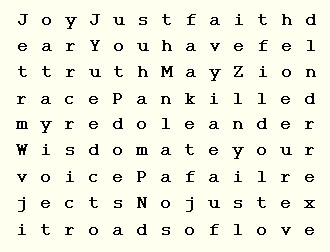
by John P. Pratt
February 14, 2006
©2006 by John P. Pratt. All rights Reserved.
Having just finished an investigation of Bible Codes, I decided to invent a new kind of word puzzle and to give my wife the very first one for Valentine's Day. The puzzle combines ideas from both the "hidden word" (or "word search") puzzles and crossword puzzles, and it uses the same encoding method of the Bible Codes. Hidden word puzzles are those with a rectangle filled with letters with hidden words which can be found by reading the letters forward, backward, vertically up or down, and diagonally forward or backward. That part is the same in the Bible Code puzzles, but the words can also be read in a straight line in any direction with letters spaced by any amount, as will be shown in the example below. The feature which is like a crossword puzzle is that related words must actually intersect each other by sharing a letter. That helps rule out words that are formed by chance.
The letters in a Bible Code puzzle can be read as normal text. My valentine stated that on this 14th day of February, the following sayings contain 14 of my favorite things:
Joy: Just faith, dear.
You have felt truth.
May Zion race.
Pan killed my red oleander.
Wisdom ate your voice.
Pa, fail rejects!
No just exit roads of love.
The more hidden words that I tried to squeeze into the puzzle, the more cryptic the sayings became. "Pan" is from Greek mythology, and two of the sentences mean: "Father, flunk those who don't measure up," and "No righteous people will depart from pathways of love." To show how it works in this first puzzle, I'll do the first two steps. First, count all the letters, omitting spaces and punctuation. In this case there are 117 letters. Then factor that number to see what possible rectangles there are. In this case, the best rectangle is 9 x 13. Now copy only the letters into a 9x13 rectangle, as shown below.
 |
The hidden words can be any set of related words. In this case they are the first names of my wife and all of our children and grandchildren. If we had children named Joy and Jet, then both of those names could be found starting with the first "J" (in the upper left-hand corner) and counting every letter across and down. All of the hidden words follow the rule to count a certain number of letters left or right and then a certain number up or down. For example, the rule for finding Joy is to count one letter to the right, and zero down. The rule for Jet is zero across and one down. The hidden words can go in any direction as long as they follow that kind of rule. For example, the name "Joy" is also found by starting on the first "J", counting four letters to the right and then down one to an "o" and then four more right and one more down to a "y". You can put a ruler along those letters to see that they are in a straight line. But once you pick a rule for a word, you must stick with it. For example, look at the "P" that starts the name "Pan." Count two letters to the right and then two down to find "a," then two more over and two down to find "u." If the name "Paul" were encoded, the last letter would also have to be two over and two down. You can see an "l" is only one over and one down, so it breaks the rule, disqualifying "Paul" as a correct answer.
All of those names shown so far were just there by chance, they are not the answers. Here are some clues to find the correct answers. My wife Ruth and I have five children: John, Julie, Mary, Jared and Joseph. All of those hidden names share a letter with my wife's name in the puzzle. John's children are Cal, Ivan and Reed. Julie's are Kaylee, Jayden and Tyler. Mary's daughter is Natalie and Jared's is Maddie. All of those children share a letter either with their parent or a brother or sister, except for Reed and Natalie, who share a letter with a cousin.
Hopefully this kind of puzzle could be fun to learn sets of related words. In this case, we are sending it to our grandchildren to learn the names of their cousins.